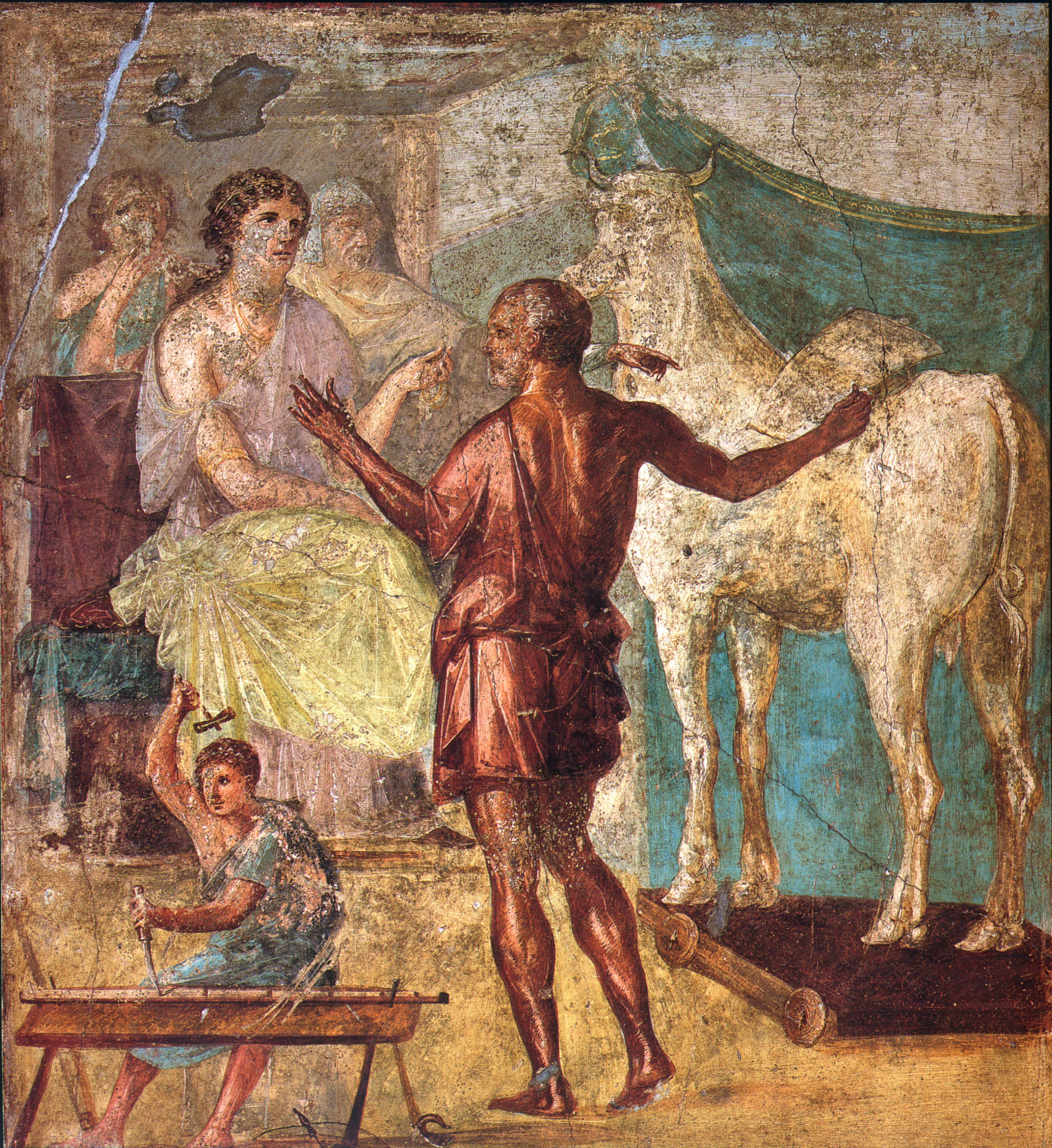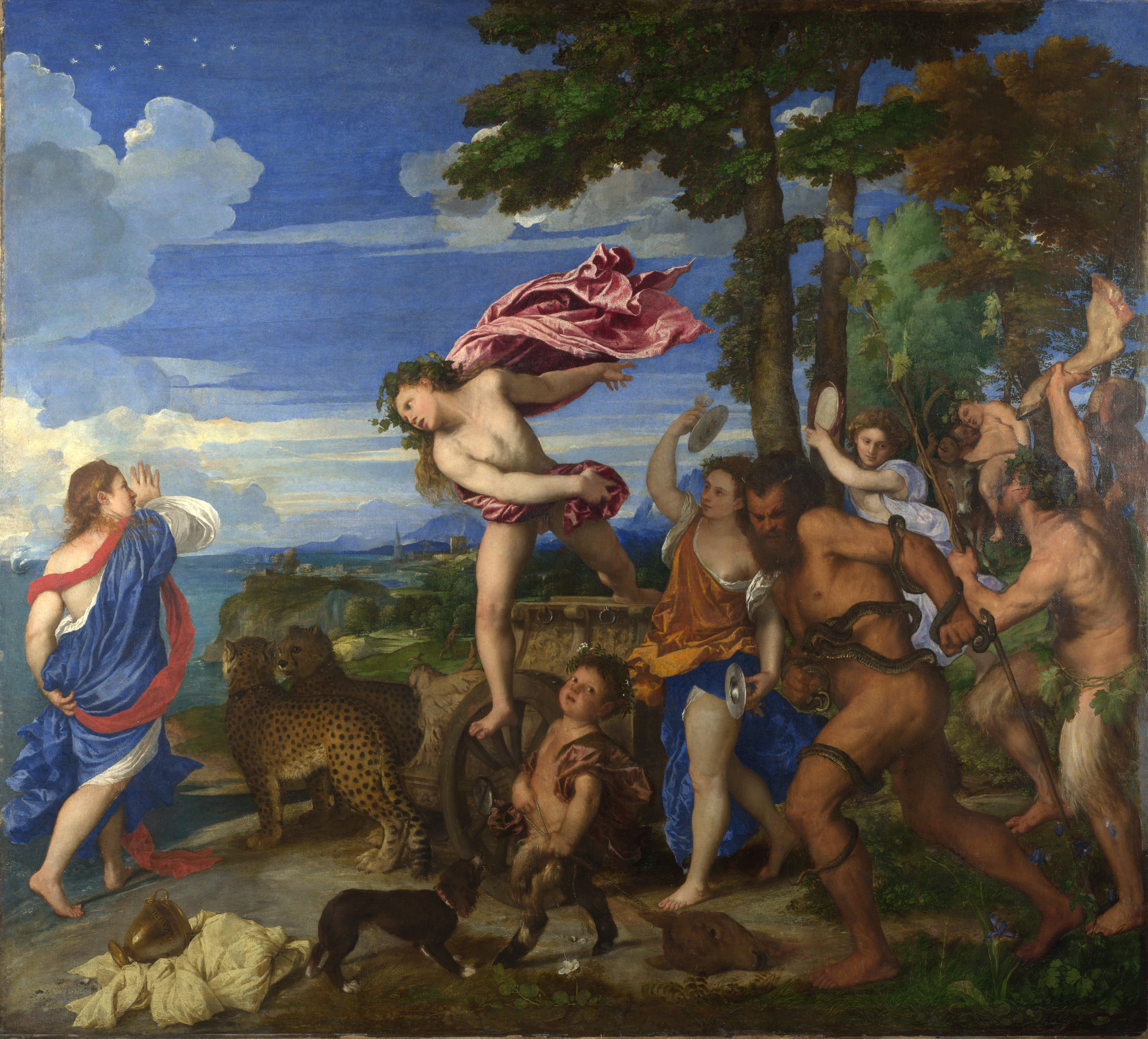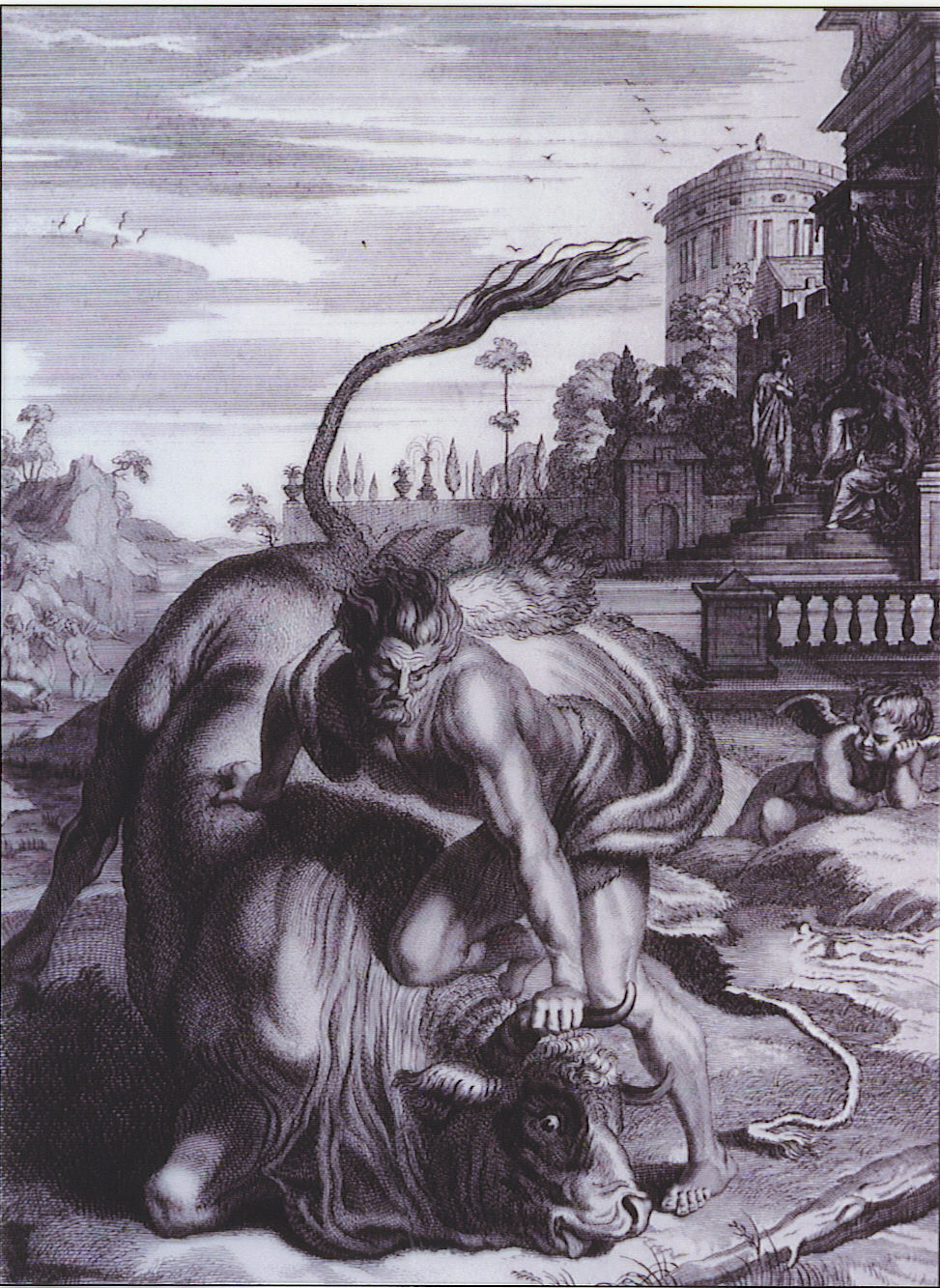|
Pasiphaë
In Greek mythology, Pasiphaë (; , derived from πᾶσι (dative plural) "for all" and φάος/φῶς ''phaos/phos'' "light") was a queen of Crete. The daughter of Helios and the Oceanid nymph Perse (mythology), Perse, Pasiphaë is notable as the mother of the Minotaur. Her husband, Minos, failed to sacrifice the Cretan Bull to Poseidon as he had promised. Poseidon then cursed Pasiphaë to fall in love with the bull. Athens, Athenian inventor Daedalus built a hollow cow for her to hide in so she could mate with the bull, which resulted in her conceiving the Minotaur. Family Parentage Pasiphaë was the daughter of List of solar deities, god of the Sun, Helios,Antoninus Liberalis41/ref> and the Oceanid nymph Perse (mythology), Perse. She was thus the sister of Aeëtes, Circe and Perses of Colchis. In some accounts, Pasiphaë's mother was identified as the island-nymph Crete (mythology), Crete herself. Like her doublet Europa (consort of Zeus), Europa, the consort of Zeus, h ... [...More Info...] [...Related Items...] OR: [Wikipedia] [Google] [Baidu] |
Minotaur
In Greek mythology, the Minotaur (, ''Mīnṓtauros''), also known as Asterion, is a mythical creature portrayed during classical antiquity with the head and tail of a bull and the body of a man or, as described by Roman poet Ovid, a being "part man and part bull". He dwelt at the center of the Labyrinth, which was an elaborate maze-like construction designed by the architect Daedalus and his son Icarus, upon command of King Minos of Crete. According to tradition, every nine years the people of Athens were compelled by King Minos to choose Sacrificial victims of the Minotaur, fourteen young noble citizens (seven men and seven women) to be offered as sacrificial victims to the Minotaur in retribution for the death of Minos's son Androgeus (son of Minos), Androgeos. The Minotaur was eventually slain by the Athenian hero Theseus, who managed to navigate the labyrinth with the help of a thread offered to him by the King's daughter, Ariadne. Etymology The word "Minotaur" derives from ... [...More Info...] [...Related Items...] OR: [Wikipedia] [Google] [Baidu] |
Helios
In ancient Greek religion and Greek mythology, mythology, Helios (; ; Homeric Greek: ) is the god who personification, personifies the Sun. His name is also Latinized as Helius, and he is often given the epithets Hyperion ("the one above") and Phaethon ("the shining"). Helios is often depicted in art with a radiant crown and driving a horse-drawn chariot through the sky. He was a guardian of oaths and also the god of sight. Though Helios was a relatively minor deity in Classical Greece, his worship grew more prominent in late antiquity thanks to his identification with several major solar divinities of the Roman period, particularly Apollo and Sol (Roman mythology), Sol. The Roman Emperor Julian (emperor), Julian made Helios the central divinity of his short-lived revival of Religion in ancient Rome, traditional Roman religious practices in the 4th century AD. Helios figures prominently in several works of Greek mythology, poetry, and literature, in which he is often described ... [...More Info...] [...Related Items...] OR: [Wikipedia] [Google] [Baidu] |
Ariadne
In Greek mythology, Ariadne (; ; ) was a Cretan princess, the daughter of King Minos of Crete. There are variations of Ariadne's myth, but she is known for helping Theseus escape from the Minotaur and being abandoned by him on the island of Naxos. There, Dionysus saw Ariadne sleeping, fell in love with her, and later married her. Many versions of the myth recount Dionysus throwing Ariadne's jeweled crown into the sky to create a constellation, the Corona Borealis. Ariadne is associated with mazes and labyrinths because of her involvement in the myths of Theseus and the Minotaur. There are also festivals held in Cyprus and Naxos in Ariadne's honor. Etymology Greek lexicographers in the Hellenistic period claimed that ''Ariadne'' is derived from the ancient Cretan dialectical elements ''ari'' (ἀρι-) "most" (which is an intensive prefix) and ''adnós'' (ἀδνός) "holy". Conversely, Stylianos Alexiou has argued that despite the belief being that Ariadne's name is of ... [...More Info...] [...Related Items...] OR: [Wikipedia] [Google] [Baidu] |
Perse (mythology)
In Greek mythology, Perse () is one of the 3,000 Oceanids, water-nymph daughters of the Titans Oceanus and Tethys. Her name was also spelled as Persa, Perseide, Persea or Perseis (, '). Perse married Helios, the god of the sun, and bore him several children, most notably the sorceress-goddess Circe. Mythology Perse was one of the wives of the sun god, Helios. According to Homer and Hesiod, with Helios she had Circe and Aeëtes, with later authors also mentioning their children Pasiphaë, Perses, Aloeus,Tzetzes ad Lycophron174 and even Calypso, who is however more commonly the daughter of Atlas. It is not clear why Perse bore Helios, the source of all light, such dark and mysterious children. When Aphrodite cursed Helios to fall in love with the mortal princess Leucothoe, he is said to have forgotten about Perse. She seems to have been linked to witchcraft and knowledge of herbs and potions, much like her daughters Circe and Pasiphaë. She might have also been assoc ... [...More Info...] [...Related Items...] OR: [Wikipedia] [Google] [Baidu] |
Cretan Bull
In Greek mythology, the Cretan Bull () was the bull Pasiphaë fell in love with, giving birth to the Minotaur. Mythology Background Minos was king in Minoan civilization, Crete. In order to confirm his right to rule, rather than any of his brothers, he prayed Poseidon send him a snow-white bull as a sign. Poseidon sent Minos the bull, with the understanding that the bull would be sacrificed to the god. Deciding that Poseidon's bull was too fine of a specimen to kill, Minos sent the bull to his herds and substituted another, inferior bull for sacrifice. Enraged, Poseidon had Aphrodite curse Pasiphaë, the wife of Minos, causing her to fall in love with the bull. She subsequently gave birth to the half-man, half-bull, Minotaur. Poseidon passed on his rage to the bull, causing him to lay waste to the land. After consulting the oracle at Delphi, Minos had Daedalus construct the Labyrinth to hold the Minotaur. The seventh labour of Heracles Heracles was sent to capture the bull ... [...More Info...] [...Related Items...] OR: [Wikipedia] [Google] [Baidu] |
Circe
In Greek mythology, Circe (; ) is an enchantress, sometimes considered a goddess or a nymph. In most accounts, Circe is described as the daughter of the sun god Helios and the Oceanid Perse (mythology), Perse. Circe was renowned for her vast knowledge of potions and herbs. Through the use of these and a magic wand or staff, she would transform her enemies, or those who offended her, into animals. The best known of her legends is told in Homer's ''Odyssey'' when Odysseus visits her island of Aeaea on the way back from the Trojan War and she changes most of his crew into swine. He manages to persuade her to return them to human shape, lives with her for a year and has sons by her, including Latinus and Telegonus (son of Odysseus), Telegonus. Her ability to change others into animals is further highlighted by the story of Picus, an Italian king whom she turns into a woodpecker for resisting her advances. Another story tells of her falling in love with the sea-god Glaucus, who prefe ... [...More Info...] [...Related Items...] OR: [Wikipedia] [Google] [Baidu] |
Perses (brother Of Aeetes)
In Greek mythology, Perses (; ) is the brother of Aeëtes, Aloeus, Circe and Pasiphaë, which makes him a son of Helios, the god of the sun, by Perse, an Oceanid nymph. Etymology His name is derived from the Ancient Greek word ''perthō'' ( – "to sack", "to ravage", "to destroy"). Mythology Perses' brother Aeëtes had been warned by an oracle that great peril would come to him if the golden fleece was ever removed from Colchis. Indeed, after Medea helped Jason steal the fleece, Perses usurped the throne of Colchis from his brother, but was subsequently slain by Medea, his paternal niece, who restored her father to the throne, as an oracle had once predicted that he would be slain by his own kin.Hyginus, ''Fabulae'27/ref> One tale goes that after Perses seized power, Medea's son by either Aegeus or Jason, Medus, arrived in Colchis and was imprisoned immediately, though under a false identity. Soon after a famine broke out. Medea arrived in Colchis too, claiming to be a p ... [...More Info...] [...Related Items...] OR: [Wikipedia] [Google] [Baidu] |
Phaedra (mythology)
In Greek mythology, Phaedra (; ) was a Crete, Cretan princess. Her name derives from the Greek word (), which means "bright." According to legend, she was the daughter of Minos and Pasiphaë, and the wife of Theseus. Later in life, Phaedra fell in love with her Stepchild, stepson, Hippolytus of Athens, Hippolytus. After he rejected her advances, she accused him of trying to rape her. In response, Theseus prayed to Poseidon and asked the god to kill Hippolytus, which he did. Phaedra then committed suicide. The story of Phaedra is told in Euripides' play ''Hippolytus (play), Hippolytus'', Seneca the Younger's ''Phaedra (Seneca), Phaedra'', and Ovid's ''Heroides''. It has inspired many modern works of art and literature, including Phèdre, a play by Jean Racine. Family Phaedra was a daughter of King Minos and Queen Pasiphaë of Crete, who had a total of eight children together. This included three daughters: Acacallis (mythology), Acacallis, Ariadne, and Xenodice (mythology), Xen ... [...More Info...] [...Related Items...] OR: [Wikipedia] [Google] [Baidu] |
Xenodice (mythology)
In Greek mythology, Xenodice or Xenodike (Ancient Greek: Ξενοδίκη) may refer to the following characters: * Xenodice, a Crete, Cretan princess as the daughter of King Minos either by Pasiphaë, Pasiphae or Crete (mythology), Crete. She was the sister of Acacallis (mythology), Acacallis, Ariadne, Androgeus (son of Minos), Androgeus, Deucalion (Cretan), Deucalion, Phaedra (mythology), Phaedra, Glaucus (son of Minos), Glaucus and Catreus. * Xenodice, a Troy, Trojan captive. (see List of children of Priam) * Xenodice, daughter of Syleus (mythology), Syleus, killed by Heracles along with her father.Tzetzes, ''Chiliades'' 2.432–425 Notes References * Bibliotheca (Pseudo-Apollodorus), Apollodorus, ''The Library'' with an English Translation by Sir James George Frazer, F.B.A., F.R.S. in 2 Volumes, Cambridge, MA, Harvard University Press; London, William Heinemann Ltd. 1921. ISBN 0-674-99135-4Online version at the Perseus Digital Library. [...More Info...] [...Related Items...] OR: [Wikipedia] [Google] [Baidu] |
Greek Mythology
Greek mythology is the body of myths originally told by the Ancient Greece, ancient Greeks, and a genre of ancient Greek folklore, today absorbed alongside Roman mythology into the broader designation of classical mythology. These stories concern the ancient Greek religion's view of the Cosmogony, origin and Cosmology#Metaphysical cosmology, nature of the world; the lives and activities of List of Greek deities, deities, Greek hero cult, heroes, and List of Greek mythological creatures, mythological creatures; and the origins and significance of the ancient Greeks' cult (religious practice), cult and ritual practices. Modern scholars study the myths to shed light on the religious and political institutions of ancient Greece, and to better understand the nature of mythmaking itself. The Greek myths were initially propagated in an oral tradition, oral-poetic tradition most likely by Minoan civilization, Minoan and Mycenaean Greece, Mycenaean singers starting in the 18th century&n ... [...More Info...] [...Related Items...] OR: [Wikipedia] [Google] [Baidu] |
Crete (mythology)
In Greek mythology, the name Crete (Ancient Greek: Κρήτη) may refer to several figures, all of whom are associated with the homonymous island of Crete, and may have been considered its eponyms: *Crete, daughter of Hesperus and one of the Hesperides and another possible eponym of Crete. *Crete, daughter of one of the Cretan Curetes, who married Ammon. She was actually said to have given her name to the island Crete, which was believed to have previously been called Idaea. *Crete, possible mother of Pasiphaë by Helios. *Crete, daughter of Asterius, who married Minos, in one version. In this regard, she was considered the mother of Acacallis, Ariadne In Greek mythology, Ariadne (; ; ) was a Cretan princess, the daughter of King Minos of Crete. There are variations of Ariadne's myth, but she is known for helping Theseus escape from the Minotaur and being abandoned by him on the island of N ..., Androgeus (son of Minos), Androgeus, Deucalion (Cretan), Deucalion, Phaedra ... [...More Info...] [...Related Items...] OR: [Wikipedia] [Google] [Baidu] |
Catreus
In Greek mythology, Catreus or Katreus (, ; ) was the eldest son of Minos and Pasiphaë, and Minos' successor as king of Crete. Catreus had one son, Althaemenes, and three daughters, Apemosyne, Aerope and Clymene. Catreus was mistakenly killed by his son Althaemenes thereby fulfilling an oracle's prophecy. Mythology According to Apollodorus' account, an oracle told Catreus that one of his children would kill him. Although Catreus kept the prophecy secret, his son Althaemenes found out, and fearing that he would be the one to kill his father, took his sister Apemosyne and left Crete for Rhodes. Catreus gave his other daughters to Nauplius to be sold off in foreign lands, and Aerope married Pleisthenes (or Atreus), but Nauplius kept Clymene for himself as wife. Years later, as an old man Catreus sailed the seas searching for his son, so that he could pass on his kingship to him. His ship stopped at Rhodes and was mistaken by some cowherds for a pirate ship. Catreus tried ... [...More Info...] [...Related Items...] OR: [Wikipedia] [Google] [Baidu] |







